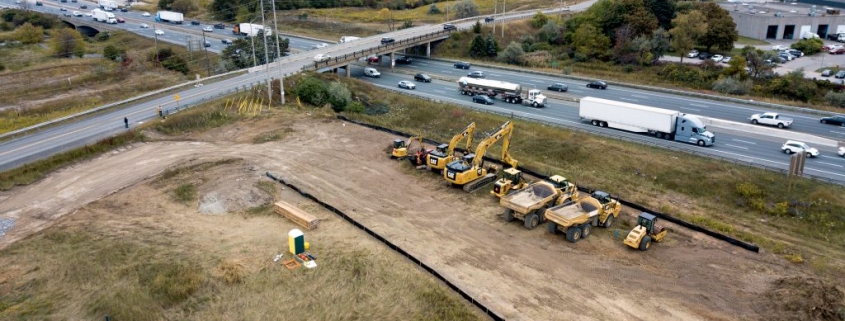The construction consortium working on a major expansion of Highway 401 from Mississauga to Milton has more than traffic and motorists to contend with.
Part of the $640-million project also involves building wildlife crossing features at several locations and mitigating the impact of construction on four species at risk.
“Three structures within the project limits accommodate wildlife passage that facilitates and improves wildlife connectivity across Highway 401,” explains Ryan Bissonnette, spokesman for West Corridor Constructors (WCC), the consortium that’s working on the 18-kilometre route over the next three years.
Wildlife crossing passages will be incorporated under the Credit River and two Oakville Creek East bridges for white-tailed deer, striped skunks, raccoons, coyotes and other mammals. The passages will be four metres high and four metres wide on each side of the watercourse. Gentle slopes will be used to guide wildlife to the passage. Steep slopes will be incorporated to discourage wildlife from climbing to the highway.
“Wildlife fencing will be installed along the highway to keep wildlife off the highway and re-direct them towards the wildlife passages,” explains Bissonnette. “Escape ramps will also be implemented so that animals can safely exit the highway right-of-way should they become trapped.”
Four species at risk have been identified within the project boundaries, including the redside dace, a type of minnow that feeds on flying insects, and American eels, whose numbers have dwindled due to hydro dam builds. Screens will be used for water intakes or outlet pipes to prevent entrainment or impingement of fish and workers will not be permitted to work at certain times near watercourse areas.
Two species of bats — the little brown myotis and eastern small-footed myotis — also reside in the corridor. To minimize the impact on them, construction activities within 30 metres of known cavity trees will be restricted to daylight hours when possible. Workers will participate in special training and as little vegetation as possible will be removed. Bat boxes will be installed to compensate for habitat removal.
Machinery to be used in an area where species are at risk will also have to arrive on-site in clean condition and must be free of fluid leaks, invasive species and noxious weeds. The equipment will also have to be washed and serviced away from watercourses.
The restrictions are outlined in an environmental assessment study done by the Ministry of Transportation and in other documents related to the project.
The ribbon of highway is being widened from the Credit River in Mississauga to Regional Road 25 in Milton and includes reconstruction of bridges as well as upgrades to support facilities and other features.
Approximately 250,000 vehicles travel on Highway 401 in the Peel and Halton regions on a daily basis. Drivers can expect to use the expanded highway by 2022.
Once completed, the expanded highway will have 12 lanes from Credit River to Winston Churchill Boulevard, 10 lanes from Winston Churchill to the Highway 407/401 interchange, 12 lanes from the 407/401 interchange to James Snow Parkway, and 10 lanes from the Parkway to Regional Road 25 at Milton, as well as HOV lanes and new or improved support features such as drainage, lighting, signage and carpool lots.
The project is being delivered through a design, build and finance, public-private partnership model, which transfers risks associated with design, construction and financing to the private sector. Using the design-build approach allows the designer and constructor to work together collaboratively, say project stakeholders.
Preliminary designs for the project were completed in 2013. Two years later, the design was completed for three of the structures in the corridor — Regional Road 25, Fifth Line and Oakville Creek West structures. Construction of those three structures has already been completed.
In spring 2019, WCC was selected as the consortium to design and build the expansion project. The consortium is comprised of Aecon Infrastructure Management Inc., Parsons Inc., and Amico Design Build Inc.
A key part of the expansion involves modifications to existing infrastructure to accommodate additional lanes on Highway 401, including nine new, replaced or widened bridges, five bridge rehabilitations, retaining wall rehabilitation and seven culvert replacements, extensions or rehabilitations.
Other structural work includes replacement and extension of culverts and construction of retaining walls.
Construction crews are currently working on an embankment in the area west of Creditview Road in Mississauga to facilitate the widened highway and expansion of bridges.
Bissonnettee says design and construction of the project are proceeding on schedule. Once major work has been initiated, construction will take place concurrently on various segments of the thoroughfare. At peak of construction, there will be approximately 200 to 250 unionized trades on the project.
Because it’s such a busy stretch of highway, Bissonnette says the largest challenge on the project will be managing traffic.
“WCC will maintain three lanes of traffic in each direction on Highway 401 during peak hours to minimize traffic impacts. All construction projects of this magnitude experience challenges. We have an experienced team in place to deliver this project on time and within budget.
“The consortium is pleased to be working on such an important project, one that will provide the travelling public with an expanded highway that will decrease travel times across the GTA.”









 Maziar Moini, Broker of Record - Home Leader Realty Inc.
300 Richmond St. W., #300, Toronto, ON M5V-1X2
Maziar Moini, Broker of Record - Home Leader Realty Inc.
300 Richmond St. W., #300, Toronto, ON M5V-1X2



